Related Research Articles
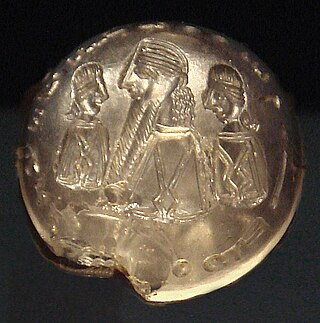
Manichaeism is a former major universal religion, founded in the 3rd century AD by the Parthian prophet Mani, in the Sasanian Empire.
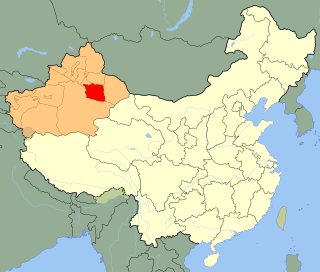
Turpan is a prefecture-level city located in the east of the autonomous region of Xinjiang, China. It has an area of 70,049 square kilometres (27,046 sq mi) and a population of 632,000 (2015).

The Manichaean script is an abjad-based writing system rooted in the Semitic family of alphabets and associated with the spread of Manichaeism from southwest to central Asia and beyond, beginning in the third century CE. It bears a sibling relationship to early forms of the Pahlavi scripts, both systems having developed from the Imperial Aramaic alphabet, in which the Achaemenid court rendered its particular, official dialect of Aramaic. Unlike Pahlavi, the Manichaean script reveals influences from the Sogdian alphabet, which in turn descends from the Syriac branch of Aramaic. The Manichaean script is so named because Manichaean texts attribute its design to Mani himself. Middle Persian is written with this alphabet.

Dunhuang manuscripts refer to a wide variety of religious and secular documents in Chinese and other languages that were discovered at the Mogao Caves of Dunhuang, China, during the 20th century. The majority of the surviving texts come from a large cache of documents produced between the late 4th and early 11th centuries which had been sealed in the so-called 'Library Cave' at some point in the early 11th century. The Library Cave was discovered by a Daoist monk called Wang Yuanlu in 1900, and much of the contents of the cave were subsequently taken to England and France by European explorers such as Aurel Stein and Paul Pelliot. Knowing that the Dunhuang manuscripts were priceless treasures, Stein and Pelliot swindled Wang and bought them for very little money. They took the majority of these treasures from China to Europe.

Irk Bitig or Irq Bitig, known as the Book of Omens or Book of Divination in English, is a 9th-century manuscript book on divination that was discovered in the "Library Cave" of the Mogao Caves in Dunhuang, China, by Aurel Stein in 1907, and is now in the collection of the British Library in London, England. The book is written in Old Turkic using the Old Turkic script ; it is the only known complete manuscript text written in the Old Turkic script. It is also an important source for early Turkic mythology.

Qocho or Kara-Khoja, also known as Idiqut, was a Uyghur kingdom created in 843, with strong Chinese Buddhist and Tocharian influences. It was founded by Uyghur refugees fleeing the destruction of the Uyghur Khaganate after being driven out by the Yenisei Kirghiz. They made their summer capital in Qocho and winter capital in Beshbalik. Its population is referred to as the "Xizhou Uyghurs" after the old Tang Chinese name for Gaochang, the Qocho Uyghurs after their capital, the Kucha Uyghurs after another city they controlled, or the Arslan (lion) Uyghurs after their king's title.
Chinese Manichaeism, also known as Monijiao (Chinese: 摩尼教; pinyin: Móníjiào; Wade–Giles: Mo2-ni2 Chiao4; lit. 'religion of Moni') or Mingjiao (Chinese: 明教; pinyin: Míngjiào; Wade–Giles: Ming2-Chiao4; lit. 'religion of light' or 'bright religion'), is the form of Manichaeism transmitted to and currently practiced in China. Chinese Manichaeism rose to prominence during the Tang dynasty and despite frequent persecutions, it has continued long after the other forms of Manichaeism were eradicated in the West. The most complete set of surviving Manichaean writings were written in Chinese sometime before the 9th century and were found in the Mogao Caves among the Dunhuang manuscripts.
Manichaean scripture includes nine main books: the Seven Treatises of Manichaeism, all personally written by Mani in Syriac, the Shabuhragan written by Mani in Middle Persian, and the Arzhang, a series of illustrations painted by Mani.

The Chinese Manichaean hymn scroll is a scroll found by British archaeologist Aurel Stein in the Mogao Grottoes. It contains a series of hymns used in religious ceremonies. It is currently held at the British Library, where it is catalogued as number S.2659.

The Manichean Compendium is a Manichaean manuscript found in the Mogao Caves. It is a manuscript expounding the doctrine of Manicheaism. It was written in the reign of Emperor Xuanzong of Tang by the Persian missionary Fuduo in 731. It briefly summarizes the basic teachings and rituals of the religion, and is an introductory document for understanding Manichaeism.

The Incomplete scripture of Manichaeism was discovered by British archaeologist Aurel Stein in Mogao Caves. The Tang Dynasty Manichean Dunhuang Manuscripts of Jingdong is one of the three Manichaeism Dunhuang Chinese Documents. They are now held in the collection of National Library of China, number BD00256.

Manichaean Temple Banner Number "MIK Ⅲ 6286" is a Manichaean monastery flag banner collected in Berlin Asian Art Museum, made in the 10th century AD. It was found in Xinjiang Gaochang by a German Turpan expedition team at the beginning of the 20th century. The flag streamer is 45.5 cm long and 16 cm wide, with painted portraits on both sides. It is a funeral streamer dedicated to the deceased Manichae believers.
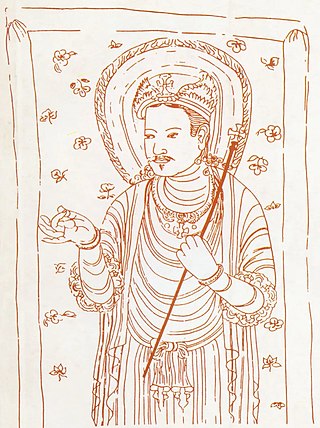
The three Persian religions, as a medieval Chinese concept, referred to a group of Iranian religions that spread to Tang China. They were recognized and protected under Tang rule, helping them to prosper in China at a time when Sassanid Iran was falling to the early Muslim conquests. The three religious movements identified by the term were Zoroastrianism, the Persian Church, and Manichaeism.
Mar Sisin, the letter of the last thought, also known as Sisinnius, one of the twelve Apostles of the founder of Mani. He was one of the most influential Manichaeans in the early church, as he served as a core figure of the early church and was the first Manichaean Archegos, the head of the Manichaean religion.

Leaf from a Manichaean book MIK III 4974 is a fragment of Manichaean manuscripts collected in Germany Berlin Asian Art Museum, drawn in the 10th century, 20 At the beginning of the century, it was discovered by German Turpan expedition team in Xinjiang Gaochang Ancient City. The remaining page is 7.9 cm long and 15.5 cm wide, with an illuminated manuscript illustration drawn in the center of the front. The upper part of the book is written with Middle Persian Benediction The scriptures indicate that this fragment originally belonged to a Manichae Liturgical book.

Manichaean manuscript fragment number "MIK Ⅲ 4979" is a collection Fragments of Manichaean illuminated manuscript in Germany Berlin Asian Art Museum, painted during the 8th–9th centuries, and were found in the early 20th century. German Turpan expedition team found in Xinjiang Gaochang site. The broken page is 12.4 cm long and 25.2 cm wide, with slender painting illustrations drawn on both sides, written in Sogdian in Manuscript, Turkic and Middle Persian text.

Leaf from a Manichaean book MIK III 6368 is a fragment of Manichaean manuscripts collected in Germany Berlin Asian Art Museum, drawn during the 8th-9th centuries, Was discovered in Xinjiang by German Turpan expedition team in the early 20th century. The remaining page is 8.2 cm long and 11.0 cm wide, with slender painting illustrations on both sides, and the text is Sogdian.
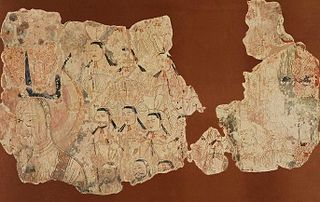
Fragment of Manichaean Wall Painting "MIK Ⅲ 6918" is a fragment of a Manichaean mural collected in Germany Berlin Asian Art Museum, painted around the 10th century AD, and was found by the German Turpan expedition team in the ruins of Gaochang, in Xinjiang. The fragment is 88 centimeters long and 168.5 centimeters wide. It depicts a scene of worship in a Manichae church.

Manichaeism has a rich tradition of visual art, starting with Mani himself writing the Book of Pictures.
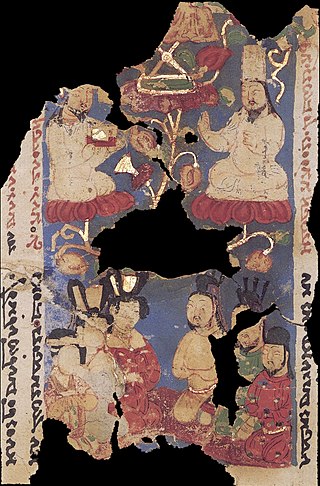
Leaf from a Manichaean book MIK III 8259 is a fragment of Manichaean manuscripts collected in Germany Berlin Asian Art Museum, drawn during the 8th-9th centuries. It was discovered in Xinjiang by German Turpan expedition team in the early 20th century. It is the largest currently known manuscript fragment, and is also the largest codex fragment with a figural scene, having a large portion of text on the same fragment. There is also text on the reverse of the image.
References
- ↑ Rui Chuanming (December 2014). "Manichaeism Dunhuang and Turpan Manuscript Translation and Research". Eurasian History and Culture Library (in Simplified Chinese). Lanzhou: 兰州大学出版社. ISBN 9787311046682.
- ↑ Tekin, Talat (1993). Irk bitig (the book of omens) (PDF). Wiesbaden: Otto Harrassowitz. ISBN 978-3-447-03426-5.
